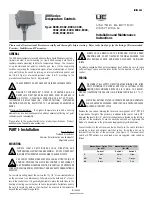
Appendix C – Introduction to Serial ATA
73
A
A
p
p
p
p
e
e
n
n
d
d
i
i
x
x
C
C
I
II
n
n
n
t
tt
r
rr
o
o
o
d
d
d
u
u
u
c
c
c
t
tt
i
ii
o
o
o
n
n
n
t
tt
o
o
o
S
S
S
e
e
e
r
rr
i
ii
a
a
a
l
ll
A
A
A
T
T
T
A
A
A
Serial ATA is a disk-interface technology that is an evolutionary advance on Parallel ATA (IDE).
Compatible with today’s software and OS-transparent, Serial ATA offers several compelling
advantages for RAID storage solutions. These include cables that are easier to route and install;
smaller connectors; faster and more reliable performance; and backwards compatibility. This
section introduces and gives an overview of the advantages of using Serial ATA in RAID.
Cabling
Serial ATA requires just seven wires (a
differential pair for both transmit and receive, as
well as three grounds) working at a low voltage
(0.7volts). Parallel ATA (IDE) on the other hand
transmits through 40 wires.
With far fewer wires, Serial ATA connectors and
cables are narrower (just 8mm wide), easier to
manipulate and connect and do not block
airflow within a system case. Heat in Serial ATA
systems disperses more easily, aiding system
stability.
A further bonus of Serial ATA is that cables can
stretch up to one meter in length giving RAID
system administrators great flexibility in setting
up their arrays. IDE cables by contrast cannot
exceed 40cm.
Simplicity of configuration
Serial ATA is based around point-to-point
connections with a single cable for each drive.
The master/slave, "daisy-chaining", and
termination issues associated with Parallel ATA
are eliminated.
Hot-Swap capability
Serial ATA drives can be connected and
disconnected at any time with no need to power
down the system. RAID system administrators
benefit from a more flexible and scalable
system. Upgrades and expansion of arrays can
be performed in an instant.
















































